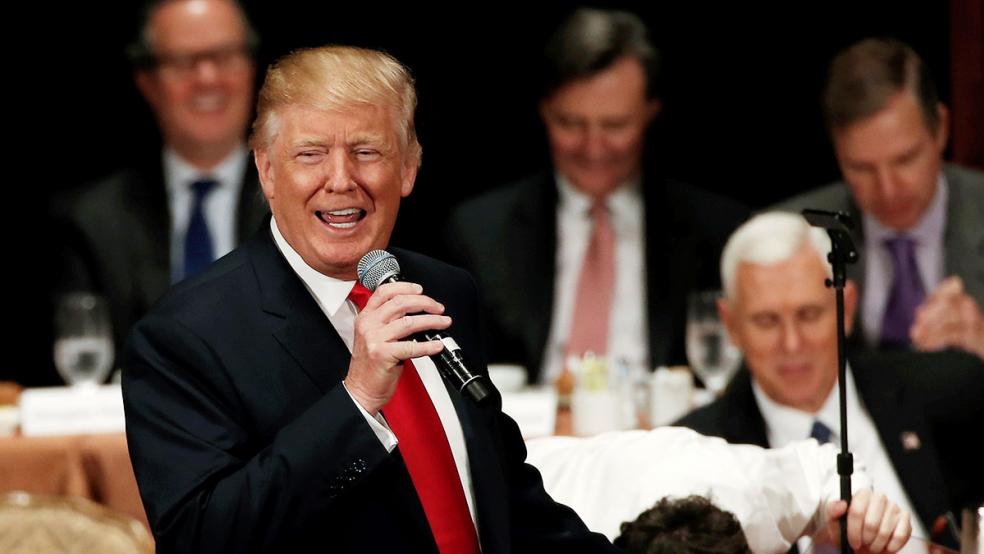The biggest surprise in the economic policy speech Donald Trump delivered in New York on Thursday wasn’t in his list of tax breaks, spending increases or his promises of “amazing” economic growth. No, the most unexpected element of Trump new plan is that someone on Team Trump, whether the candidate himself or his economic advisers, appears to be listening to its critics for a change.
Earlier in the campaign, Trump released a proposal so extravagant in its promises of tax cuts and economic growth that even the most charitable analysts had to concede that it would add something on the order of $10 trillion to the federal deficit over a ten-year period.
Related: Is the Race Tied? Why Trump Isn’t Really That Close to Winning
The plan Trump announced on Thursday is dramatically less profligate. There hasn’t been time for independent experts to fully analyze its effects, but on first glance economists said that it would at least not be as damaging to the country as Trump’s original proposal.
Douglas Holtz-Eakin, the former director of the Congressional Budget Office and now head of the conservative non-profit American Action Forum, sounded encouraged -- mostly -- by the changes he saw in the Trump plan.
“It shows they took the budget criticism seriously,” he said. “It seems like a much more serious effort to make the numbers add up.”
However, he conceded, “I’m still not convinced that it adds up.”
The plan Trump unveiled Thursday comes with a claim by people identified as “Trump economists” that it “would conservatively boost growth to 3.5 percent per year on average” over the next 10 years.
Far from being conservative, most mainstream economists view that promise as wildly optimistic.
Related: The Billionaire's Daughter Quietly Shaping the Trump Campaign
The Trump plan collapses the current income tax system into a three-rate structure (12, 25, and 33 percent) while greatly increasing the standard deduction and capping itemized deductions at $100,000 per person or $200,000 for a married couple. Combined with sizeable child care tax deductions, the plan would result in zero tax liability for many low income households. It could also potentially raise the tax bill for wealthy people who rely on large tax deductions, but the details were not immediately clear.
The plan would also slash business taxes from 35 percent to 15 percent, and would apply a 10 percent tax to companies repatriating earnings from overseas. Business would be allowed to immediately write off investments in plants and equipment.
The plan would treat carried interest as regular income, eliminating a loophole that allowed wealthy investment managers to pay an artificially low income tax rate. However, it appears to leave in place an even bigger loophole by treating pass-through income from a corporation as business income. This would enable business owners to shelter massive amounts of income from taxation.
Trump also pledged a major decrease in regulation of business activity including, oddly, a promise to eliminate food safety requirements that cover “farm and food production hygiene, food packaging, food temperatures.”
Related: With Clinton Campaigning Again, Trump Renews Attacks on Her Health
He included his usual tirade against trade deals and his promise to “unleash” the American energy industry, despite the fact that the country is producing its own energy at record rates already.
Finally, he proposed what he called a “Penny Plan” that would reduce all non-defense discretionary spending by one percent every year for ten years.
Economist Leonard Burman, director of the Urban-Brookings Tax Policy Center in Washington, said that the campaign had not released enough information for his organization to do a serious analysis of the Trump plan’s effect on tax revenue, but he was skeptical about the promises of economic growth and, particularly, about the campaign’s ability to make its numbers add up after promising not to touch military spending, Medicare or Social Security.
“It’s going to be a real challenge,” Burman said drily. “He’s eliminated all the biggest programs.”
Holtz-Eakin, of the American Action Forum, was a little more inclined to charity.
He praised the focus on growth, saying, “I thought it was, number one, a clear and sharp contrast of a candidate who believes growth is an imperative with the Democrats, who have given up on growth.”
Related: Powell Email Leak Shows Reluctance to Attack Trump
However, he was skeptical of Trump’s promises of economic growth more than doubling under his plan and dismissed out of hand the promised 1 percent per year reduction in non-defense spending for the next decade. “There’s no way,” he said.
Like many conservative economists, he is also deeply unhappy with Trump’s anti-trade positions. “They’re bad. Terrible,” he said. The damage done to the economy through Trump’s plans to impose tariffs and otherwise restrict trade would offset much of what Holtz-Eakin sees as the good effects of the tax and regulatory changes. “The trade stuff is an unambiguous negative,” he said.





